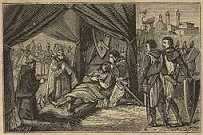
Sceau de Thibaud V, 1259, Document conservé au Centre
historique des Archives nationales à Paris, Cote SC/CH6 (c) ARCHIM
|
With the death of Thibaud IV, it was
his wife Marguerite De Bourbon who maintained the Regency of the County, although she did
not wait for her son Thibaud's maturity before crowning him as King of Navarre in 1253.
After 3 years of regency, Marguerite returned the County to Thibaud, who become, in 1256,
Count Thibaud V. Son-in-law of Saint Louis since his marriage with Isabelle the elder
daughter of the King, Thibaud cultivated a close relationship with the King; he was by no
means opposed to the loss of certain privileges, when Saint Louis decided notably to take
charge of justice and currency in the Champagne lands, thus bringing to an end the
celebrated Provinois contributions in 1263. |

Saint Louis
|
In 1269, Thibaud V and Isabelle
decided to follow Saint Louis to Constantinople; it was necessary to find funds to finance
the army which would accompany them and Thibaud did not hesitate for this occasion to
confiscate all the goods of the Champagne Jews. Their belongings and wealth were quite
simply taken on his command! On August 27, 1270, when Saint Louis died of dysentery, close
to Carthage, Thibaud V was at his bedside. |

Mort de Saint Louis
|
|
On December 4, 1271,
it was the turn of our Count to succumb to the fever. His wife, became a widow and an
orphan in a few months, and died the following summer, on the return journey.

Sceau de Philippe le Bel, 1285, Document conservé au Centre
historique des Archives nationales à Paris, Cote SC/B13bis (c) ARCHIM
|
After the
court reigns (3 years) of Thibaud V's brother, Henri III, and the regency of his wife,
Blanche of Artois, the lineage of Counts died out: Champagne integrated into the Kingdom
of France by the marriage of Jeanne of Navarre (daughter of Blanche and Henri) to the
future King Philippe IV "the handsome" in 1284. |

Sceau de Jeanne de Navarre, Document conservé au Centre historique
des Archives nationales à Paris, Cote SC/D157 (c) ARCHIM
|
By way of conclusion...
This union put an end to more than three centuries
of the existence of the Champagne County. The Counts were very much differing from the
other vassals of the King of France; the management of their lands was decided not by
simple territory quarrels but above all by true political and commercial strategy.
It was initially the development of the Champagne
Fairs, famous throughout Europe, which permitted the County, thanks to the four fair towns
- Bar sur Aube, Troyes, Sézanne and Provins, on a South-east - North-west line - to
organize a succession of fairs throughout the year, and in so doing to collect numerous
taxes on the trading, ensuring the prosperity of the region.
It was as well an unparalleled spiritual "
development ", that the devotion of certain Counts would support; Count Thibaud I
who, in addition to his support of many religious orders, gave his son Eudes (Pope Urbain
II) to the papacy - Count Hugues and the creation of the Knights of the Templars - the
friendship which bound Thibaud II Le Grand and Bernard of Clairvaux - Henri I the Liberal
and the assistance that he gave to the abbeys in the County - the major part the counts
took in the Crusades, with the accession of Henri II to the throne of Jerusalem in 1190.
The Champagne court was also a privileged place of intellectual and artistic meetings, in
particular under the regency of Blanche of Navarre and the reign of her son, Thibaud the
Chansonnier "Singer/Poet".
Lastly, political strategy was also carefully
managed by the well thought out unions, which made it possible to protect or expand the
County - with the marriage between Thibaud III and Blanche of Navarre for example - or to
reinforce the links between the Counts and the Kingdom of France - with the marriages of
Henri I and Marie, daughter of Louis VII, and Thibaud V and Isabelle, daughter of Saint
Louis.
The impression of this splendour and prosperity
will stay with the Comtale city of Troyes for a long time, which until XVIth century was
one of the grandest cities of the Kingdom - the fifth under the reign of François I. |






